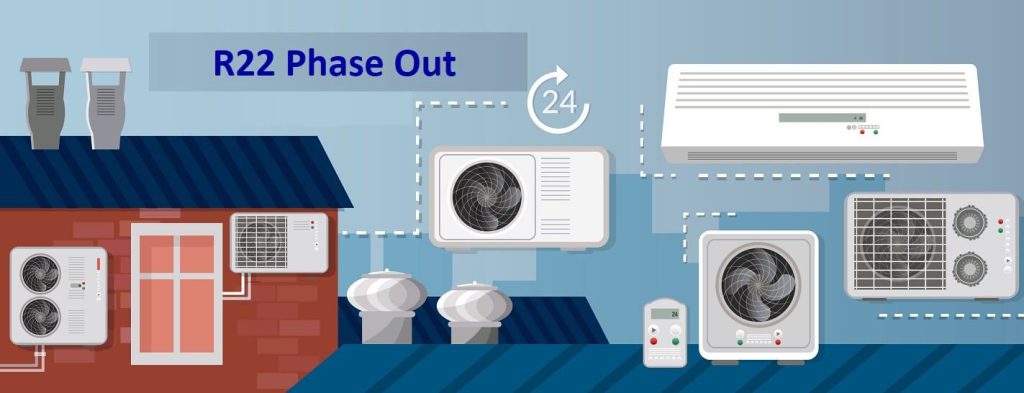What Happens When R22 is Phased Out?

Australia does not produce HCFCs and has since slowly minimised the importation of bulk HCFCs since 1996. The country’s yearly importation of HCFCs drastically reduced from 250 ODPt (ozone-depleting potential tonnes) to 2.5 ODPt between 1996 and 2016. This phase-out is majorly supported by the illegalization of new equipment containing HCFCs.
So what are the uses of R22?
R22 has mostly been used in commercial and residential HVAC and refrigeration systems from the 1990s, after the phase-out of CFCs (chlorofluorocarbons) in 1995. R22 equipment is increasingly attaining the end of its lifespan and is being replaced with the latest equipment that uses totally different refrigerants.
Some quick facts regarding the R22 phase out:
- Australia has significantly phased out the importation of R22 as well as other HCFCs.
- Between 2016 and 2029 imports are restricted to 2.5 ODPt of HCFC every year. This translates to about 45 tonnes of R22.
- From 1st Jan 2030, the importation of bulk R22 will be banned completely.
- From 1st Jan 2020, bulk R22 imported into Australia will only be used for servicing existing HVAC and refrigeration devices.
- From 2030 onwards, the servicing of R22 systems will largely depend on reclaimed refrigerant.
- The use of reclaimed R22 is legal. However reclaimed R22 must be tested to establish that it meets the manufacturer’s specifications to ascertain its quality. Kindly call your refrigerant supplier for more details.
- The cost of R22 may fluctuate depending on its availability and demand. What is the matter with R22 equipment?
- It is important to note that new R22 air conditioning as well as refrigeration can neither be manufactured nor imported into Australia with exceptions being some spare parts and under some unique situations.
- Existing R22 that is already in Australia will not be illegalized. What is more they don’t need to be retrofitting.
- Existing systems that use R22 can be serviced using R22. Routine servicing can potentially benefit owners in a number of ways including reduced energy costs as well as reduced cost of replacement for the leaked refrigerant.
- If your R22 unit is in tip-top condition, then you do not have to change it to an alternative system or refrigerant. Nevertheless, new equipment usually boasts higher efficiency and may also feature a fairly smaller refrigerant charge and reduced leakage rate and as a result can be somewhat cheaper to operate.
- Spare parts can sometimes prove difficult to find as R22 equipment becomes outdated.
- Retrofitting your current unit to use a non-HCFC refrigerant is also possible. Regardless, it is important to note that retrofits should only be conducted if the alternative refrigerant is compatible with that particular equipment and should be done in line with the relevant legislation and Australian regulations.
In regard to the Montreal Protocol on substances that lead to the depletion of the ozone layer all member states of the United Nations are required to stop both the production and the importation of ozone-depleting substances such as R22.
Transition to other refrigerants:
The heating and cooling as well as the refrigeration industry are already adequately prepared in the transition from R22. The use of R22 in refrigeration has declined substantially in the last few years a trend that is only projected to continue. Hydrofluorocarbons such as R-410a and R-134a are today the most common refrigerants accounting for nearly 81% of refrigerant use in Australia. HFCs are currently being phased out in Australia and globally, and this is because of the damage these carbons do to the ozone layer.
What does the law say?
The Australian Government’s Synthetic Greenhouse Gas Management and Ozone Protection legislation has formulated certain legal requirements for using controlled HCFC, HFC as well as CFC refrigerants. These guidelines are intended to curb the discharge of refrigerant into the atmosphere.
First and foremost, it is imperative to note that refrigerant must never be vented or discharged, except in extremely limited scenarios and must be recovered by a qualified licensed professional when equipment nears the end of its life. What is more, all projects on systems that contain these refrigerants must be conducted by highly qualified and well-trained technicians. Technicians need to comply with all the relevant authorities’ laws and regulations, industry standards such as electrical safety standards. It is also important to note that anyone or a company that violates any of these regulations may face a penalty of $63,000 and $315,000 respectively.
You need to consult the relevant authorities in your local area to make sure you strongly adhere to the local regulations.
If you are looking to substitute your R22 with an alternative refrigerant, it is important that you check your local regulations as well as your manufacturer’s requirements. This is because there may be a need to modify either the unit or its immediate environment to meet compliance with relevant standards and legislation.
So, what are some of the licensing requirements as far as the handling of refrigerants is concerned?
Licenses to either trade or handle controlled HFC, HCFC or CFC refrigerants are administered by the Australian Refrigeration Council at www.arctick.org:
- A refrigerant trading authorization is mandatory for any business or person that acquires, owns, or discards controlled equipment.
- A refrigerant handling license is needed to decant refrigerant, install, manufacture, commission, service or maintain equipment, regardless of whether or not a controlled refrigerant is existing. Besides, this license coves the disposal or decommissioning of equipment that contains controlled refrigerant.
- A restricted refrigerant recover license is one license option for people who remove controlled refrigerant from any HVAC or refrigeration unit.
It is also worth noting that extra licensing requirements may be needed to work with some or all refrigerants in some jurisdictions or states. This simply implies that you need to consult the relevant authorities in your local area.
